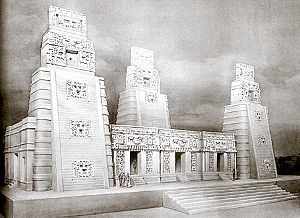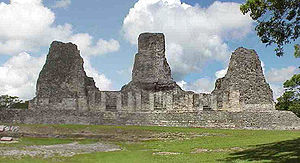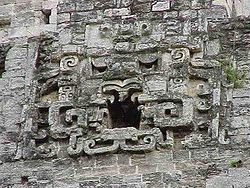
Xpuhil
Encyclopedia
Xpuhil Pronounced:/ʃpuχil̥/ (also Xpujil) is a Maya
archaeological site located in the Mexican state of Campeche
, in the vicinity of the modern-day town of Xpujil
. The area surrounding Xpuhil, along Federal Highway 186
, is rich with other Maya sites, including Becan
and Calakmul
.


 The name xpuhil means "cat's tail" in reference to a type of vegetation found locally.
The name xpuhil means "cat's tail" in reference to a type of vegetation found locally.
Evidence at the site indicates settlement as early as 400 BC. The pre-Columbian inhabitants of Xpuhil reached their zenith between AD 500 and 750, and went into decline around 1100.
Xpuhil was rediscovered in the late 1930s. To date, 17 groups of constructions have been uncovered, which mostly follow Río Bec
architectural canons. Structure I is of particular interest because it is not in the Río Bec style, with its three towers and atypical distribution of interior spaces.
Maya civilization
The Maya is a Mesoamerican civilization, noted for the only known fully developed written language of the pre-Columbian Americas, as well as for its art, architecture, and mathematical and astronomical systems. Initially established during the Pre-Classic period The Maya is a Mesoamerican...
archaeological site located in the Mexican state of Campeche
Campeche
Campeche is one of the 31 states which, with the Federal District, comprise the 32 Federal Entities of Mexico. Located in Southeast Mexico, it is bordered by the states of Yucatán to the north east, Quintana Roo to the east, and Tabasco to the south west...
, in the vicinity of the modern-day town of Xpujil
Xpujil
Xpujil is a town in the Mexican state of Campeche. It serves as the municipal seat for the surrounding municipality of Calakmul.Xpujil is located in the south-east of the state, close to the border with Quintana Roo to the east and Peten to the south...
. The area surrounding Xpuhil, along Federal Highway 186
Mexican Federal Highway
Mexican Federal Highways, are roads maintained and built by the federal government of Mexico, through the Secretariat of Communications and Transportation ....
, is rich with other Maya sites, including Becan
Becan
Becan is an archaeological site of the Maya civilization in pre-Columbian Mesoamerica. Becan is located near the center of the Yucatán Peninsula, in the present-day Mexican state of Campeche, about 150 km north of Tikal. The Maya sites of Balamku, Calakmul, Chicanna and Xpuhil are nearby...
and Calakmul
Calakmul
Calakmul is a Maya archaeological site in the Mexican state of Campeche, deep in the jungles of the greater Petén Basin region. It is from the Guatemalan border. Calakmul was one of the largest and most powerful ancient cities ever uncovered in the Maya lowlands...
.



Evidence at the site indicates settlement as early as 400 BC. The pre-Columbian inhabitants of Xpuhil reached their zenith between AD 500 and 750, and went into decline around 1100.
Xpuhil was rediscovered in the late 1930s. To date, 17 groups of constructions have been uncovered, which mostly follow Río Bec
Rio Bec
Río Bec is a Pre-Columbian Maya archaeological site located in what is now southern portion of the Mexican state of Campeche. The name also refers to an architectural style that first appeared at Río Bec and subsequently spread to other nearby sites...
architectural canons. Structure I is of particular interest because it is not in the Río Bec style, with its three towers and atypical distribution of interior spaces.

